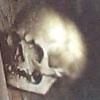
A fun way to do this was "anamorphosis." Probably the most famous example of this is in a painting by Hans Holbein called "The Ambassadors." There, what seems like a misshapen grey blob at the bottom suddenly forms a perfectly 3-d image when looked at from the side, that of a human skull!
What's more, according to anamorphosis.com,
anamorphosis is closely related to an artistic technique called trompe l'oeil (French for "deceiving the eye", pronounced "tromp loy"). Both use perspective constructions to create a "trick" image, but the difference lies in the nature of the trick. For an anamorphosis, the viewer is presented with something that does not make sense when viewed conventionally, and so he or she must seek out the unconventional viewpoint from which the trick is resolved. For trompe l'oeil, the viewer, standing in one particular (and usually conventional) place, is tricked into seeing an invented image as if it were reality.
Venice is full of these! Just to name a couple of examples, there are the ceilings of the churches of Sant' Alvise in the sestiere of Cannaregio and San Pantalon in the sestiere of Santa Croce (even if these photos aren't taken from the correct angle for the illusion to work!), not to mention ceiling paintings throughout the Ducal Palace by Veronese, the most splendid of which may be the magnificent "Apotheosis of Venice" in the chamber of the Major Council!
But playing with anamorphosis didn't end with the Renaissance! Julian Beever is a contemporary street artist whose amazing work is what got me thinking about all this in the first place... Don't miss it!!
Categories: Italy, Venice, Art, Fun&Games
No comments:
Post a Comment